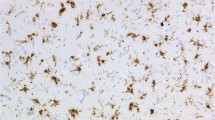Abstract
Purpose
In developed countries, lead intoxication is decreasing in adults as sources of contamination were considerably reduced. Hence, cases of lead encephalopathy have become scarcer. We report the case of a 50-year-old woman who developed a systemic intoxication due the persistence of lead fragments in her abdomen and back. The patient was shot with homemade gun bullets, which were immediately surgically removed. During the eight following months, she presented progressive worsening signs of systemic and cerebral lead intoxication. On admission to hospital, her blood lead concentration was of 1650 µg/L. Despite surgeries and the use of lead chelators, she died 8 days later.
Methods
Organs were harvested during postmortem autopsy for pathological investigations, and cerebral lead concentration was determined using inductively coupled plasma–mass spectrometry.
Results
Lead encephalopathy was confirmed based on elevated lead concentration measured in brain (3.04 µg/g in cortex and 2.70 µg/g in nucleus lentiformis). Furthermore, neuropathological examination highlighted a strong blood brain barrier (BBB) disruption.
Conclusions
Based on this fatal lead intoxication case, it appears that BBB leakage is a major pathological sign of lead encephalopathy and that lead titration in formalin-fixed brain tissue is a valuable tool for diagnosis.


Similar content being viewed by others
Change history
14 October 2022
A Correction to this paper has been published: https://doi.org/10.1007/s11419-022-00647-5
References
Frery N, Guldner L, Saoudi A, Garnier R, Zeghnoun A, Bidondo ML (2011) Exposition de la population française aux substances chimiques de l’environnement. Saint-Maurice, Institut de veille sanitaire, p 151
Agency for Toxic Substances and Disease Registry (2007) Toxicological profile: lead. https://www.atsdr.cdc.gov/toxprofiles/tp.asp?id=96&tid=22
Kehoe RA (1976) Pharmacology and toxicology of heavy metals: lead. Pharmcol Ther 1:161–188. https://doi.org/10.1016/0362-5478(76)90006-1
Valpey R, Sumi SM, Copass MK, Goble GJ (1978) Acute and chronic progressive encephalopathy due to gasoline sniffing. Neurology 28(5):507–510. https://doi.org/10.1212/wnl.28.5.507
Letournel F, Etcharry-Bouyx F, Verny C, Barthelaix A, Dubas F (2003) Two clinicopathological cases of a dominantly inherited, adult onset orthochromatic leucodystrophy. J Neurol Neurosurg Psychiatry 74(5):671–673. https://doi.org/10.1136/jnnp.74.5.671
McAninch SA, Adkison J, Meyers R, Benham M (2017) Bullet fragment-induced lead arthopathy with subsequent fracture and elevated blood lead levels. Proc (Bayl Univ Med Cent) 30(1):88–91. https://doi.org/10.1080/08998280.2017.11929543
Grandjean P, Arnvig E, Beckmann J (1978) Psychological dysfunctions in lead-exposed workers. Relation to biological parameters of exposure. Scand J Work Environ Health 4(4):295–303. https://doi.org/10.5271/sjweh.2696
Garcès G, Bernardo J, Artuz M, Ignacio R (2012) Secondary lead poisoning housed in the human body. Colombia Med 43(3):230–234. https://doi.org/10.25100/cm.v43i3.788
Di Maio VJM, Gariott J (1983) A fatal case of lead poisoning due to a retained bullet. Am J Forensic Med Pathol 4(2):165–169. https://doi.org/10.1097/00000433-198306000-00013
Baranowska-Bosiacka I, Gutowska I, Rybicka M, Nowacki P, Chlubek D (2012) Neurotoxicity of lead. Hypothetical molecular mechanisms of synaptic function disorders. Neurol Neurochir Polska 46(6):569–578
Bressler JP, Goldstein GW (1991) Mechanisms of lead neurotoxicity. Biochem Pharmacol 41:479–484. https://doi.org/10.1016/0006-2952(91)90617-e
Sanders T, Liu Y, Buchner V, Tchounwou PB (2009) Neurotoxic effects and biomarkers of lead exposure: a review. Rev Environ Health 24(1):15–45
Reyes PF, Gonzalez CF, Zalewska MK, Besarab A (1986) Intracranial calcification in adults with chronic lead exposure. AJR Am J Roentgenol 146(2):267–270. https://doi.org/10.2214/ajr.146.2.267
Schroter C, Schroter H, Huffman G (1991) Neurologic and psychiatric manifestations of lead poisoning in adults (case report and review of the literature). Fortsche Neurol Psychiatry 59(10):413–424. https://doi.org/10.1055/s-2007-1000716
Author information
Authors and Affiliations
Corresponding author
Ethics declarations
Conflict of interest
There are no financial, or other, relations that could lead to a conflict of interest.
Ethical approval
The case selected for this work underwent medicolegal autopsy directed by judicial authorities. The publication of this article was authorized by a judge, and the manuscript was submitted after the end of the court proceeding. For the control sample, the national register for opposition was consulted and there was no opposition. Moreover, the control samples are stored in the center for biological resources at the corresponding author's affiliated hospital, as required by the French legislation.
Additional information
Publisher's Note
Springer Nature remains neutral with regard to jurisdictional claims in published maps and institutional affiliations.
The original online version of this article was revised to update Ethical approval text.
Rights and permissions
Springer Nature or its licensor (e.g. a society or other partner) holds exclusive rights to this article under a publishing agreement with the author(s) or other rightsholder(s); author self-archiving of the accepted manuscript version of this article is solely governed by the terms of such publishing agreement and applicable law.
About this article
Cite this article
Lelievre, B., Triau, S., Codron, P. et al. A chasing dead-end case report: a fatal lead intoxication following an attempted homicide. Forensic Toxicol 38, 505–510 (2020). https://doi.org/10.1007/s11419-019-00519-5
Received:
Accepted:
Published:
Issue Date:
DOI: https://doi.org/10.1007/s11419-019-00519-5




